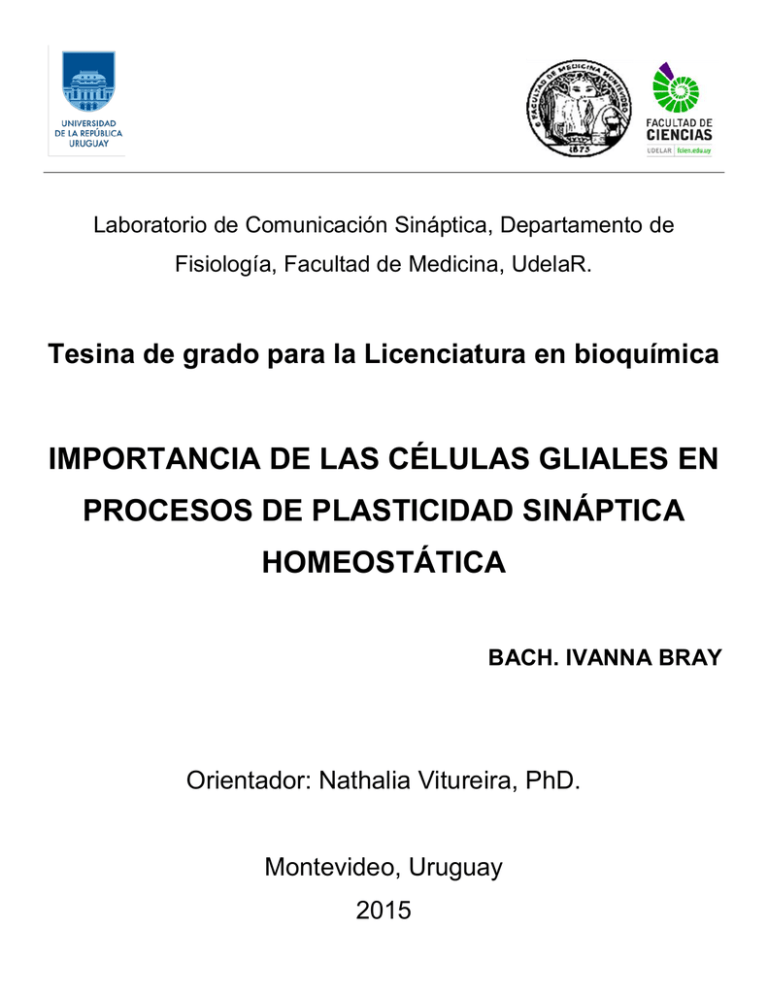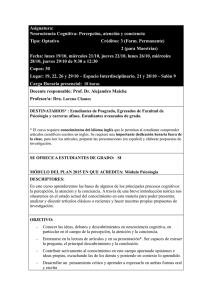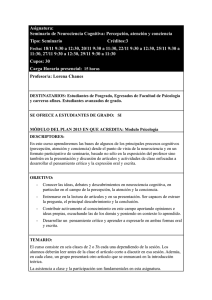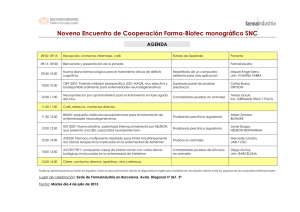importancia de las células gliales en procesos de plasticidad
Anuncio

Laboratorio de Comunicación Sináptica, Departamento de Fisiología, Facultad de Medicina, UdelaR. Tesina de grado para la Licenciatura en bioquímica IMPORTANCIA DE LAS CÉLULAS GLIALES EN PROCESOS DE PLASTICIDAD SINÁPTICA HOMEOSTÁTICA BACH. IVANNA BRAY Orientador: Nathalia Vitureira, PhD. Montevideo, Uruguay 2015 AGRADECIMIENTOS Quiero agradecer a todos los que de alguna forma formaron parte de este trabajo: A Nathalia Vitureira por la orientación y tutoría. A Francesco Rossi por la revisión del trabajo. Al personal del laboratorio de virología de Facultad de Ciencias, que nos prestó la sala de cultivo mientras refaccionaban la de Facultad de Medicina. A todo el Departamento de histología de la Facultad de Medicina por permitirnos utilizar su sala de cultivo y ayudarnos cada vez que lo necesitamos, en especial a Patricia Cassina, Laura Martínez, Ernesto Miquel, Sebastián Rodríguez y Valentina Lagos. A Alicia Costa, Luciana Benedetto y Verónica Abudara por la colaboración en los experimentos. A Hugo Peluffo por la donación de anticuerpos. A Marcela Alsina y a los integrantes del laboratorio de genética por la ayuda brindada en el día a día. A Mariela Santos, Martín Breijo y todo el personal de U.R.B.E. A Marcela Díaz por la orientación al utilizar el microscopio confocal del Instituto Pasteur. A Mariana Firpi por la orientación al utilizar el microscopio de epifluorescencia del la Facultad de Medicina. A mi familia, por el apoyo brindado durante este tiempo, especialmente a Adrian, Graciela, Mathías, Laila, Edda y Mario. A mis amigos y compañeros, los que compartieron parte de la carrera conmigo y los que no, que por suerte son muchos para nombrarlos y no quiero olvidarme de ninguno. 2 Índice Resumen .................................................................................... 4 Introducción .............................................................................. 5 Objetivo ...................................................................................... 20 Materiales y métodos ................................................................ 21 Resultados ................................................................................. 26 Discusión ................................................................................... 38 Conclusiones ............................................................................. 43 Bibliografía ................................................................................. 44 3 Resumen La actividad neural se encuentra bajo dos requerimientos opuestos: la necesidad de cambio y la necesidad de estabilidad. Los cambios en la actividad neural se producen mediante alteraciones en el número y fuerza de las conexiones sinápticas, de forma dependiente de la actividad neuronal, y permite que las propiedades del circuito se refinen con la experiencia. Resulta interesante cuestionar como se mantiene cierto grado de constancia en las propiedades básicas de un circuito cuando este necesita tanto del cambio como de la estabilidad. Recientemente se ha identificado un tipo de plasticidad sináptica denominada “Plasticidad Sináptica Homeostática”, la cual se propone, es la encargada de mantener la estabilidad del circuito. Este tipo de plasticidad se define como un mecanismo de “feedback negativo” utilizado por las neuronas para compensar la excitación o inhibición excesivas mediante el ajuste de la eficacia sináptica (Pozo and Goda, 2010). No hasta hace poco tiempo, la transferencia y el procesamiento de información en el sistema nervioso eran considerados procesos llevados a cabo exclusivamente por las neuronas. Sin embargo, recientemente se ha identificado que las células gliales desempeñan un rol mucho más activo en estos procesos (Araque and Navarrete, 2010). Por este motivo, estamos interesados en investigar el rol que cumplen las células gliales en la plasticidad sináptica homeostática. Para esto, nos propusimos validar una técnica de imagenología que resulte lo suficientemente sensible para estimar cambios en la función presináptica y analizar la inducción y/o mantenimiento de este tipo de plasticidad en cultivos neuronales en contacto con células gliales o en su ausencia o escasa presencia de estas. Los resultados obtenidos sugieren que las células gliales cumplen un papel esencial en la correcta inducción y/o mantenimiento de la plasticidad sináptica homeostática. Si bien resta mucho por investigar respecto a este tipo de plasticidad, la comprensión de este fenómeno y del rol relevante que cumplen las células gliales des de gran relevancia ya que se propone que defectos en la plasticidad sináptica homeostática se encuentran vinculados con estados patológicos del sistema nervioso, como por ejemplo, la epilepsia. Palabras clave: Plasticidad sináptica homeostática; células gliales; sistema nervioso; función sináptica; astrocitos 4 Bibliografía Abbott, L.F., and Nelson, S.B. (2000). Synaptic plasticity : taming the beast. Nat. Neurosci. 3, 1178–1183. Abbott, L.F., and Regehr, W.G. (2004). Synaptic computation. Nature 431, 796–803. Abraham, W.C., and Bear, M.F. (1996). Metaplasticity : plasticity of synaptic plasticity. Trends Neurosci. 19, 126–130. Araque, A., and Navarrete, M. (2010). Glial cells in neuronal network function. Philos. Trans. R. Soc. Lond. B. Biol. Sci. 365, 2375–2381. Araque, A., Carmignoto, G., Haydon, P.G., Oliet, S.H.R., Robitaille, R., and Volterra, A. (2014). Gliotransmitters Travel in Time and Space. Neuron 81, 728–739. Bacci, A., Coco, S., Pravettoni, E., Schenk, U., Armano, S., Frassoni, C., Verderio, C., Camilli, P. De, and Matteoli, M. (2001). Chronic Blockade of Glutamate Receptors Enhances Presynaptic Release and Downregulates the Interaction between Synaptophysin- Synaptobrevin – Vesicle-Associated Membrane Protein 2. J. Neurosci. 21, 6588–6596. Beatiie, M.S., Malenka, R.C., Beattie, E.C., Stellwagen, D., Morishita, W., Bresnahan, J.C., Ha, B.K., and Zastrow, M. Von (2002). Control of Synaptic Strength by Glial TNFα. Science. 295, 2282–2285. Branco, T., Staras, K., Darcy, K.J., and Goda, Y. (2008). Local dendritic activity sets release probability at hippocampal synapses. Neuron 59, 475–485. Burrone, J., O’Byrne, M., and Murthy, V.N. (2002). Multiple forms of synaptic plasticity triggered by selective suppression of activity in individual neurons. Nature 420, 414–418. Del Castillo, J., and Katz, B. (1954). Quantal Components Of The End-Plate Potential. J. Physiol. 124, 560– 573. Custer, K.L., Austin, N.S., Sullivan, J.M., and Bajjalieh, S.M. (2006). Synaptic vesicle protein 2 enhances release probability at quiescent synapses. J. Neurosci. 26, 1303–1313. D. Purves (2007). Neurociencia, 3ª edición, Buenos Aires, Editorial Panamericana. Desai, N.S. (2004). Homeostatic plasticity in the CNS: synaptic and intrinsic forms. J. Physiol. Paris 97, 391– 402. Han, E.B., and Stevens, C.F. (2009). Development regulates a switch between post and presynaptic strengthening in response to activity deprivation. Proc. Natl. Acad. Sci. U. S. A. 106, 10817–10822. Harris, K.M., and Weinberg (2012). Ultrastructure of Synapses in the Mammalian Brain. Cold Spring Harb. Perspect. Biol. 4, 1–30. Henneberger, C., Papouin, T., Oliet, S.H.R., and Dmitri, A. (2010). Long term potentiation depends on release of D-serine from astrocytes. Nature 463, 232–236. 44 Herman, M. a, Ackermann, F., Trimbuch, T., and Rosenmund, C. (2014). Vesicular glutamate transporter expression level affects synaptic vesicle release probability at hippocampal synapses in culture. J. Neurosci. 34, 11781–11791. Ibata, K., Sun, Q., and Turrigiano, G.G. (2008). Rapid synaptic scaling induced by changes in postsynaptic firing. Neuron 57, 819–826. De Jong, A.P.H., Schmitz, S.K., Toonen, R.F.G., and Verhage, M. (2012). Dendritic position is a major determinant of presynaptic strength. J. Cell Biol. 197, 327–337. Jourdain, P., Bergersen, L.H., Bhaukaurally, K., Bezzi, P., Santello, M., Domercq, M., Matute, C., Tonello, F., Gundersen, V., and Volterra, A. (2007). Glutamate exocytosis from astrocytes controls synaptic strength. Nat. Neurosci. 10, 331–339. Kilman, V., Rossum, M.C.W. Van, and Turrigiano, G.G. (2002). Activity Deprivation Reduces Miniature IPSC Amplitude by Decreasing the Number of Postsynaptic GABA A Receptors Clustered at Neocortical Synapses. J. Neurosci. 22, 1328–1337. Kirov, S. a, Goddard, C.A., and Harris, K.M. (2004). Age-dependence in the homeostatic upregulation of hippocampal dendritic spine number during blocked synaptic transmission. Neuropharmacology 47, 640–648. Lazarevic, V., Schöne, C., Heine, M., Gundelfinger, E.D., and Fejtova, A. (2011). Extensive remodeling of the presynaptic cytomatrix upon homeostatic adaptation to network activity silencing. J. Neurosci. 31, 10189– 10200. Lisman, J.E., Raghavachari, S., and Tsien, R.W. (2007). The sequence of events that underlie quantal transmission at central glutamatergic synapses. Nat. Rev. Neurosci. 8, 597–609. Lissin, D., Gomperts, S., and Reed, C. (1998). Activity differentially regulates the surface expression of synaptic AMPA and NMDA glutamate receptors. Proc. Nat. Acad. Sci. USA 95, 7097–7102. Liu, Z. (2005). Molecular mechanism of TNF signaling and beyond. Nature 15, 24–27. Mammen, A.L., Huganir, R.L., and Brien, R.J.O. (1997). Redistribution and Stabilization of Cell Surface Glutamate Receptors during Synapse Formation. J. Neurosci. 17, 7351–7358. Marder, E., and Goaillard, J.-M. (2006). Variability, compensation and homeostasis in neuron and network function. Nat. Rev. Neurosci. 7, 563–574. Moulder, K.L., Jiang, X., Taylor, A.A., Olney, J.W., and Mennerick, S. (2006). Physiological activity depresses synaptic function through an effect on vesicle priming. J. Neurosci. 26, 6618–6626. Murthy, V.N., Schikorski, T., Stevens, C.F., Zhu, Y., and Jolla, L. (2001). Inactivity Produces Increases in Neurotransmitter Release and Synapse Size. Neuron 32, 673–682. Mutch, S.A., Kensel-hammes, P., Gadd, J.C., Fujimoto, B.S., Allen, R.W., Schiro, P.G., Lorenz, R.M., Kuyper, C.L., Jason, S., Bajjalieh, S.M., et al. (2011). Protein quantification at the single vesicle level reveals that a subset of synaptic vesicle proteins are trafficked with high precision. J. Neurosci. 31, 1461–1470. 45 Navarrete, M., and Araque, A. (2010). Endocannabinoids potentiate synaptic transmission through stimulation of astrocytes. Neuron 68, 113–126. Navarrete, M., Perea, G., Fernandez de Sevilla, D., Gómez-Gonzalo, M., Núñez, A., Martín, E.D., and Araque, A. (2012). Astrocytes mediate in vivo cholinergic-induced synaptic plasticity. PLoS Biol. 10, e1001259. O’Brien, R., Kamboj, S., and Ehlers, M. (1998). Activity-dependent modulation of synaptic AMPA receptor accumulation. Neuron 21, 1067–1078. Orellana, J.A., Martinez, A.D., and Retamal, M.A. (2013). Gap junction channels and hemichannels in the CNS: regulation by signaling molecules. Neuropharmacology 75, 567–582. Perea, G., and Araque, A. (2005). Properties of synaptically evoked astrocyte calcium signal reveal synaptic information processing by astrocytes. J. Neurosci. 25, 2192–2203. Pozo, K., and Goda, Y. (2010). Unraveling mechanisms of homeostatic synaptic plasticity. Neuron 66, 337– 351. Rutherford, L.C., Nelson, S.B., and Turrigiano, G.G. (1998). BDNF Has Opposite Effects on the Quantal Amplitude of Pyramidal Neuron and Interneuron Excitatory Synapses. Neuron 21, 521–530. Sheng, M., and Kim, E. (2011). The postsynaptic organization of synapses. Cold Spring Harb. Perspect. Biol. 3, 1–20. Shiraishi-Yamaguchi, Y., and Furuichi, T. (2007). The Homer family proteins. Genome Biol. 8, 206. Stellwagen, D., and Malenka, R.C. (2006). Synaptic scaling mediated by glial TNF-alpha. Nature 440, 1054– 1059. Stellwagen, D., Beattie, E.C., Seo, J.Y., and Malenka, R.C. (2005). Differential regulation of AMPA receptor and GABA receptor trafficking by tumor necrosis factor-alpha. J. Neurosci. 25, 3219–3228. Südhof, T.C. (2013a). The Presynaptic Active Zone. Neuron 75, 11–25. Südhof, T.C. (2013b). Neurotransmitter Release: The Last Millisecond in the Life of a Synaptic Vesicle. Neuron 80, 675–690. Sutton, M. a, Ito, H.T., Cressy, P., Kempf, C., Woo, J.C., and Schuman, E.M. (2006). Miniature neurotransmission stabilizes synaptic function via tonic suppression of local dendritic protein synthesis. Cell 125, 785–799. Thiagarajan, T.C., Lindskog, M., and Tsien, R.W. (2005). Adaptation to synaptic inactivity in hippocampal neurons. Neuron 47, 725–737. Tokuoka, H., and Goda, Y. (2008). Activity-dependent coordination of presynaptic release probability and postsynaptic GluR2 abundance at single synapses. Proc. Natl. Acad. Sci. U. S. A. 105, 14656–14661. Turrigiano, G.G (1999). Homeostatic plasticity in neuronal networks: the more things change, the more they stay the same. Trends Neurosci. 22, 221–227. 46 Turrigiano, G.G. (2000). AMPA receptors unbound: membrane cycling and synaptic plasticity. Neuron 26, 5– 8. Turrigiano, G.G. (2006). More than a sidekick: glia and homeostatic synaptic plasticity. Trends Mol. Med. 12, 455–458. Turrigiano, G.G. (2008). The self-tuning neuron: synaptic scaling of excitatory synapses. Cell 135, 422–435. Turrigiano, G.G., and Nelson, S.B. (1998). Thinking Globally , Acting Locally : AMPA Receptor Turnover What determines the strength of a synapse , and how. Neuron 21, 1997–1999. Turrigiano, G.G., and Nelson, S.B. (2004). Homeostatic plasticity in the developing nervous system. Nat. Rev. Neurosci. 5, 97–107. Vitureira, N., and Goda, Y. (2013). The interplay between Hebbian and homeostatic synaptic plasticity. J. Cell Biol. 203, 175–186. Vitureira, N., Letellier, M., and Goda, Y. (2012a). Homeostatic synaptic plasticity: from single synapses to neural circuits. Curr. Opin. Neurobiol. 22, 516–521. Vitureira, N., Letellier, M., White, I.J., and Goda, Y. (2012b). Differential control of presynaptic efficacy by postsynaptic N-cadherin and β-catenin. Nat. Neurosci. 15, 81–89. Wallach, G., Lallouette, J., Herzog, N., De Pittà, M., Ben Jacob, E., Berry, H., and Hanein, Y. (2014). Glutamate mediated astrocytic filtering of neuronal activity. PLoS Comput. Biol. 10, e1003964. Wilson, N.R., Kang, J., Hueske, E. V, Leung, T., Varoqui, H., Murnick, J.G., Erickson, J.D., and Liu, G. (2005). Presynaptic Regulation of Quantal Size by the Vesicular Glutamate Transporter VGLUT1. 25, 6221– 6234. Zhang, Z., Gong, N., Wang, W., Xu, L., and Xu, T.-L. (2008). Bell-shaped D-serine actions on hippocampal long-term depression and spatial memory retrieval. Cereb. Cortex 18, 2391–2401. Zhao, C., Dreosti, E., and Lagnado, L. (2011). Homeostatic synaptic plasticity through changes in presynaptic calcium influx. J. Neurosci. 31, 7492–7496. Zhuang, Z., Yang, B., Theus, M.H., Sick, J.T., Bethea, J.R., and Thomas, J. (2011). EphrinBs regulate D-serine synthesis and release in astro- cytes. J. Neurosci. 30, 16015–16024. 47


